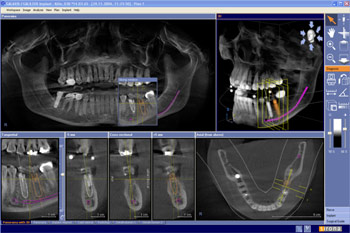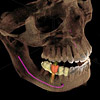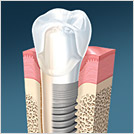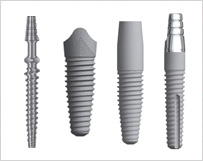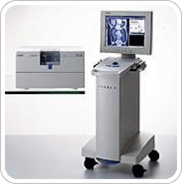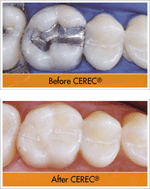|
|
THE NEW WAY TO SEE
GALILEOS-3D is now central to our practice. We recently incorporated the GALILEOS® 3D Cone Beam imaging solution from Sirona. Sirona’s technology extends diagnostic X-ray imaging potential for better patient treatment. The visualization tools available in the software assist us with better, more certain
diagnosis. They allow our office to coordinate treatment planning with colleagues
and to explain treatments visually to our patients with greater clarity and accuracy. “It’s very comprehensive,” Dr. Doty says. Conventional images taken in most dental offices are two-dimensional. “We’re seeing things we couldn’t see before,”said Dr. Coty. 3D images make the X-ray diagnosis and implant treatment safer, more predictable and faster. The Sirona system provides a three dimensional image of the patient on the computer screen and the surgery is performed virtually for the patient review. Then at the time of treatment customized guides specific to the patient and the case assist with accurate implant placement. This allows for faster more comfortable surgery.
· Easy sharing of images and diagnostic information with referring doctors
Restorative
& Cosmetic Dentistry.
Composite (tooth-colored) and silver amalgam fillings are used to repair a tooth that is affected by decay, cracks,
fractures, etc. The decayed or affected portion of the tooth will be removed and then filled with a filling and bonded into
place.
Dr. Doty or Dr. Cody will discuss the best options for restoring your teeth. Composite fillings, along with silver
amalgam fillings, are the most widely used today. It usually only takes one appointment to place a filling. While the tooth is numb, Dr. Coty or Dr. Doty will remove any decay, thoroughly clean and prep the tooth before the new filling is placed. If the decay was near the nerve of the tooth, a special medication will be applied for added protection. The filling will then be precisely placed, shaped, and polished, restoring your tooth to its original shape and function.
When the fillings are first placed, you may have some hot and cold sensitivity, but this will subside. It is important
to follow the care instructions given to you.
Let's
talk about Dental Implants Dental
implants are artificial tooth replacements that are used to counter tooth loss. The procedure is categorized as a form of
prosthetic (artificial replacement) dentistry, though it also falls into the category of cosmetic dentistry as well.
Although you have a number of restorative options for the treatment of missing teeth, none have proven to be as functionally
effective and durable as implants. In many cases, dental implants may be the only logical choice for the restoration of all
necessary functionality of the teeth and supporting structures. Tooth Loss
Teeth are lost because of: Tooth decay Root canal failure Periodonitits (gum disease)Trauma to the mouth Excessive
wear and tear Congenital defects
People who have lost teeth might feel too self-conscious to smile or talk. Additionally, biting irregularities caused
by tooth loss can have a negative effect on eating habits and this can lead to secondary health problems like malnutrition.
Regardless of the nature of problems related to tooth loss, dental implants may provide a simple remedy with proven results. Advantages of Implant Dentistry at Dr. Doty & Associates
Dental implants are stronger and more durable than their restorative counterparts (bridges and dentures). Implants
offer a permanent solution to tooth loss. Additionally, implants may be used in conjunction with other restorative procedures
for maximum effectiveness. For example, a single implant can serve to support a crown replacing a single missing tooth. Implants
can also be used to support a dental bridge for the replacement of multiple missing teeth, and can be used with dentures to
increase stability and reduce gum tissue irritation.
Procedural advancements, including the development of narrower “mini” implants, mean that more people than
ever before are finding themselves candidates for implantation. The Dental Implant Procedure
Today's dental implants are virtually indistinguishable from other teeth. This appearance is aided in part by the structural
and functional connection between the dental implant and the living bone. Implants are typically placed in a single sitting
but require a period of osseointegration.
Osseointegration is the process by which direct anchorage of a dental implant root and the bone of the jaw occurs.
Osseointegrated implants are the most commonly used and successful type of dental implant. An osseointegrated implant takes
anywhere from three to six months to anchor and heal, at which point your dentist can complete the procedure with the placement
of a crown. Once the implant has anchored with the jawbone, artificial prosthesis may be attached and the process is done.
If osseointegration does not occur, the implant will fail. Detailed procedural steps are as follows:
Preparing the Jaw for Implantation: A dental implant is commonly composed of a titanium material screw and a crown.
A small-diameter hole (pilot hole) is drilled at edentulous (where there is no tooth) jaw sites in order to guide the titanium
screw that holds a dental implant in place. To avoid damaging vital jaw and face structures like the inferior alveolar nerve
in the mandible (lower jaw), a dentist must use great skill and expertise when boring the pilot hole and sizing the jaw bone. Placement of the Implant: After the initial pilot hole has been drilled into the appropriate jaw site, it is slowly widened to allow for placement of the implant screw. Following this placement, a protective cover screw is placed on top to allow the implant site to heal and the dental implant to anchor (osseointegration). After several months, the protective cover is removed and a temporary crown is placed on top of the dental implant. The temporary crown serves as a template around which the gum grows and shapes itself in a natural way. The process is completed when the temporary crown is replaced with a permanent crown. Implant treatment has advanced rapidly. Today we can many times place implants the same day a tooth is removed. This procedure has the advantage of only one surgery, saving the bone, and much quicker replacement of the lost tooth
Success Rates of Dental Implants
Dental implants are among the most successful procedures in dentistry. There is no guarantee that an implant procedure
will be successful, but studies have shown a five-year success rate of 95% for lower jaw implants and 90% for upper jaw implants.
The success rate for upper jaw implants is slightly lower because the upper jaw (especially the posterior section) is less
dense than the lower jaw, making successful implantation and osseointegration potentially more difficult to achieve. Lower
posterior implantation has the highest success rate for all dental implants.
Dental implants may fail for a number of reasons. The cause is often related to a failure in the osseointegration process.
For example, if the implant is placed in a poor position, osseointegration may not take place. Dental implants may break or
become infected (like natural teeth) and crowns may become loose.
If you are a smoker who is considering a dental implant, Dr. Doty or Dr. Cody will likely advise you to give up smoking
before undergoing the process because smokers face a higher risk of implant failure. Since the procedure can be extremely
expensive, you risk wasting your money on dental implants if you do not give up the habit.
On the plus side, dental implants are not susceptible to the formation of cavities; still, poor oral hygiene can lead
to the development of peri-implantitis around dental implants. This disease is tantamount to the development of periodontitis
(severe gum disease) around a natural tooth. Implant Dentistry: New Procedural Strategies
Dr. Doty is trained to perform implants, crowns and/or surgery and has begun to use a new strategy for the replacement
of missing teeth. Dental implants are placed into locations where teeth have recently been extracted. When successful, this
new strategy can shed months off of the treatment time associated with dental implants because osseointegration is sped up.
Candidacy for this type of early intervention is dependant upon anatomical factors of the extracted tooth site. For example,
in many cases the extracted tooth site is wider than the implant, making it impossible to place the implant into the site
immediately after extraction. Dental work would have to be performed first in order to create a perfect fit for the implant.
Narrower implants may be used for small teeth and incisors. Also, a narrower implant may best serve patients who require
stabilization of lower jaw dentures, pre-molar teeth, or a missing tooth that was located in a narrow area. A small number
of narrower implants are FDA-approved for the purpose of prosthesis stabilization, including the mini-dental implant.
There are some core differences between traditional implants and mini implants: Mini implants are approximately half
the width of their traditional counterparts. The implant is not fully submerged during a narrow implant procedure. Should
implant failure occur, the small size (that of a toothpick) means grafting is not necessary. Mini implants are less costly.
Mini implants are solid though they do not contain a screw.
Conventional & Partial Dentures
A denture is a removable dental prosthesis that replaces missing teeth and surrounding tissue. They are made to closely
resemble your natural teeth and may even enhance your smile.
There are two types of dentures - complete and partial dentures. Complete dentures are used when all of the teeth are
missing, while partial dentures are used when some natural teeth remain. A partial denture fills in the spaces created by
missing teeth and prevents other teeth from shifting out of alignment.
A complete denture may be either “conventional” or “immediate.” A conventional type is made
after the teeth have been removed and the gum tissue has healed, for a period of 4 to 6 weeks. During this time the patient
will go without teeth. Immediate dentures are made in advance and immediately placed after the teeth are removed, thus preventing
the patient from having to be without teeth during the healing process. Once the tissues shrink and heal, adjustments are
made as needed to idealize fit and comfort.
Conventional partials offer good retention by using the remaining natural teeth as anchors. Conventional full dentures
on the other hand have a major disadvantage of poor retention due to lack of fixed anchorage. Implant supported dentures are
now the treatment of choice as they offer superior stability, retention and durability.
The process of getting dentures
The process of getting dentures requires several appointments. Highly accurate impressions and measurements are taken
and used to create your custom denture. Several “try-in” appointments may be necessary to ensure proper shape,
color, and fit. At the final appointment, Dr. Cody or Dr. Doty will precisely adjust and place the completed denture, ensuring
a natural and comfortable fit.
It is normal to experience increased saliva flow, some soreness, and possible speech and chewing difficulty during
the adjustment period. However this will subside as your muscles and tissues get used to the new dentures. It is important
to follow the care instructions for your new dentures. Proper cleaning of your new dental appliance, good oral hygiene, and
regular dental visits will lengthen the life of your new dentures. Fixed Bridges
Dental implants are considered the most durable option of replacing missing teeth; however in some cases fixed bridges
are more appropriate. A dental bridge is a fixed (non-removable) appliance and can be an excellent way to replace missing
teeth.
There are several types of bridges. Dr. Doty or Dr. Cody will discuss the best options for you and your particular
case. The “traditional bridge” is the most popular type and is usually made of porcelain fused to metal. This
type of bridge consists of two crowns that go over two anchoring teeth and are attached to one or more artificial teeth, filling
the gap created by one or more missing teeth.
The process of getting a fixed
bridge
The process of getting a fixed bridge usually requires two or more visits. At the first visit, the doctor will numb the teeth and prepare the two anchoring teeth by removing a portion of enamel to allow for a
crown. An impression is then made and sent to a dental laboratory where the bridge will be fabricated. A temporary bridge
will be made and worn for several weeks until your next appointment.
During the second visit, your permanent bridge will be carefully checked, adjusted, and cemented in place to achieve
a proper fit and bite. It is important to follow the care instructions for your new dentures. Proper cleaning of your new
dental appliance, good oral hygiene, and regular dental visits will lengthen the life of your fixed bridge.
Porcelain Veneers in ONE DAY Veneers are very thin pieces of durable, tooth shaped porcelain that are custom made by in our office, which are bonded onto the front surface of teeth. Veneers can give you a whole new smile. They are considered to be a conservative alternative to crowns and are used in treating many dental conditions. Reasons for porcelain veneers:
■To create a uniform smile
■Crooked teeth
■Worn or chipped teeth
■Stained or extremely discolored teeth
■Unwanted or uneven spaces
The process of getting veneers
It only takes one visit to complete the process of getting veneers. During the procedure, little or no anesthesia is
required. The teeth are prepared by lightly buffing and shaping the surface to allow for the thickness of the veneer. Our Cerec Machine is used to take an impression of the teeth and is then computer
created by Dr. Doty or Dr. Coty and milled in our state of the art laboratory. After the creating and milling, the teeth will be cleansed with special liquids to ensure a greater durable bond. Bonding cement is then placed between the tooth and veneer, with the bond being set with a special light beam. It is important that you follow the special care instructions that will be given to you along with proper brushing, flossing and regular dental visits to lengthen life of your new veneers.
Cerec Crowns (Caps)
A crown, also known as a cap, covers the entire tooth surface to restore it to its original shape and size. If a tooth
cannot be restored with fillings or other types of restorations, a crown is used to protect and strengthen the tooth structure.
While there are several types of crowns to choose from, porcelain crowns are the most popular as they most closely
resemble your natural teeth in size, shape and color. Porcelain is highly durable and will last many years.
Reasons for crowns:
■Broken or Fractured Teeth
■Cosmetic Enhancement ■Decayed Teeth
■Fractured Fillings
■Large Fillings
■Tooth has a Root Canal
The process of getting a crown
Our crowns are milled right here at Dr. Doty & Associates and in two hours you will walk out with your new crown.
The tooth is numbed and Dr. Doty or Dr. Cody prepares the tooth by removing any decay and shaping the surface to properly
fit the crown. As you sit there you will watch the Dr. computer generate a new crown right before your eyes. After the milling
process Dr. Doty or Dr. Cody will then carefully place your new crown to ensure correct spacing and bite. It is important
that you follow the special care instructions that will be given to you along with regular dental visits to check your new
crown.
|
